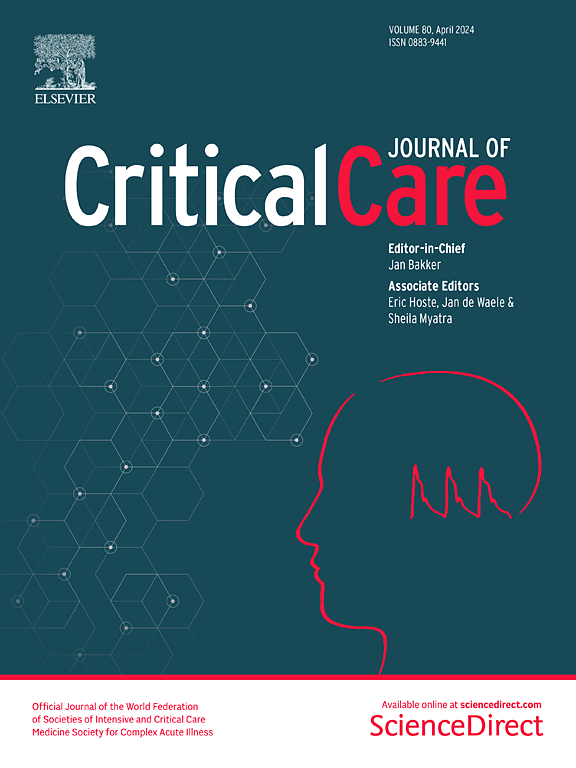利用潜类分析鉴定需要进行 ECMO 的重度 ARDS 的新型亚型
IF 8.8
1区 医学
Q1 CRITICAL CARE MEDICINE
引用次数: 0
摘要
急性呼吸窘迫综合征(ARDS)的亚表型有助于评估 ARDS 的严重程度或预测其对特定治疗策略的反应性,但尚未有研究对需要静脉体外膜肺氧合(V-V ECMO)的重度 ARDS 患者的异质性进行调查。我们对接受 V-V ECMO 治疗的重度 ARDS 成人患者进行了这项回顾性多中心观察研究。我们根据开始使用 ECMO 支持时的放射学和临床结果进行了潜类分析(LCA),以确定重度 ARDS 的亚型。我们进行了多变量 Cox 回归分析,以研究死亡率的差异以及 PEEP 设置≥ 10 cmH2O 与亚型死亡率之间的关联。通过分析 544 名接受 V-V ECMO 治疗的重度 ARDS 患者的数据,我们确定了以下三种亚型:干型(185 人;34%);湿型(169 人;31%);纤维化型(190 人;35%)。纤维化型患者的 90 天院内死亡风险高于干型(调整后危险比 [95% 置信区间] 1.75 [1.10-2.79],p = 0.019)或湿型(1.50 [1.02-2.23],p = 0.042)。ECMO 头 3 天 PEEP 设置≥ 10 cmH2O 只降低了湿性患者 90 天的院内死亡风险,而干性或纤维化患者则没有降低。在湿润型和 PEEP 设置≥ 10 cmH2O 之间,观察到了与 90 天院内死亡率相关的显着交互效应(pinteraction = 0.036)。三个亚型显示了不同的死亡率以及 V-V ECMO 早期较高 PEEP 设置与患者预后之间的不同关系。我们的数据表明,在 V-V ECMO 期间,我们可能需要根据临床亚型改变对严重 ARDS 患者的管理方法。本文章由计算机程序翻译,如有差异,请以英文原文为准。
Identification of novel sub-phenotypes of severe ARDS requiring ECMO using latent class analysis
Sub-phenotyping of acute respiratory distress syndrome (ARDS) could be useful for evaluating the severity of ARDS or predicting its responsiveness to given therapeutic strategies, but no studies have yet investigated the heterogeneity of patients with severe ARDS requiring veno-venous extracorporeal membrane oxygenation (V-V ECMO). We conducted this retrospective multicenter observational study in adult patients with severe ARDS treated by V-V ECMO. We performed latent class analysis (LCA) for identifying sub-phenotypes of severe ARDS based on the radiological and clinical findings at the start of ECMO support. Multivariate Cox regression analysis was conducted to investigate the differences in mortality and association between the PEEP setting of ≥ 10 cmH2O and mortality by the sub-phenotypes. We identified three sub-phenotypes from analysis of the data of a total of 544 patients with severe ARDS treated by V-V ECMO, as follows: Dry type (n = 185; 34%); Wet type (n = 169; 31%); and Fibrotic type (n = 190; 35%). The 90-days in-hospital mortality risk was higher in the patients with the Fibrotic type than in those with the Dry type (adjusted hazard ratio [95% confidence interval] 1.75 [1.10–2.79], p = 0.019) or the Wet type (1.50 [1.02–2.23], p = 0.042). The PEEP setting of ≥ 10 cmH2O during the first 3 days of ECMO decreased the 90-days in-hospital mortality risk only in patients with the Wet type, and not in those with the Dry or Fibrotic type. A significant interaction effect was observed between the Wet type and the PEEP setting of ≥ 10 cmH2O in relation to the 90-day in-hospital mortality (pinteraction = 0.036). The three sub-phenotypes showed different mortality rates and different relationships between higher PEEP settings in the early phase of V-V ECMO and patient outcomes. Our data suggest that we may need to change our management approach to patients with severe ARDS during V-V ECMO according to their clinical sub-phenotype.
求助全文
通过发布文献求助,成功后即可免费获取论文全文。
去求助
来源期刊

Critical Care
医学-危重病医学
CiteScore
20.60
自引率
3.30%
发文量
348
审稿时长
1.5 months
期刊介绍:
Critical Care is an esteemed international medical journal that undergoes a rigorous peer-review process to maintain its high quality standards. Its primary objective is to enhance the healthcare services offered to critically ill patients. To achieve this, the journal focuses on gathering, exchanging, disseminating, and endorsing evidence-based information that is highly relevant to intensivists. By doing so, Critical Care seeks to provide a thorough and inclusive examination of the intensive care field.
 求助内容:
求助内容: 应助结果提醒方式:
应助结果提醒方式:


